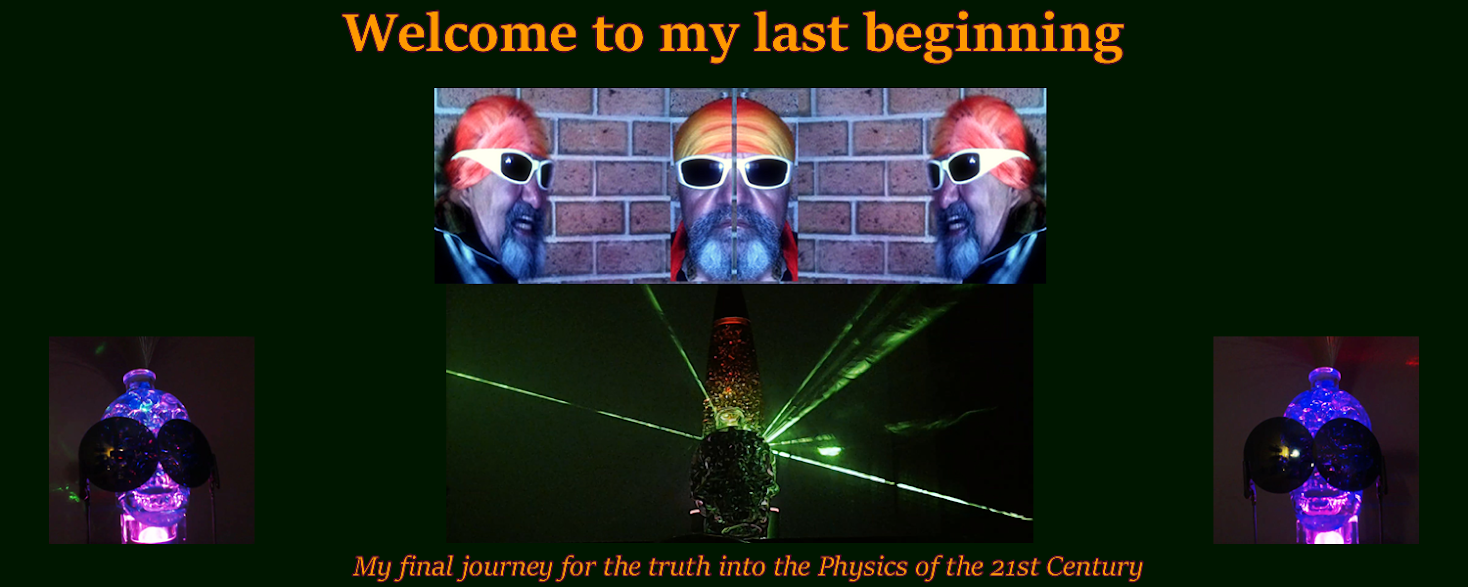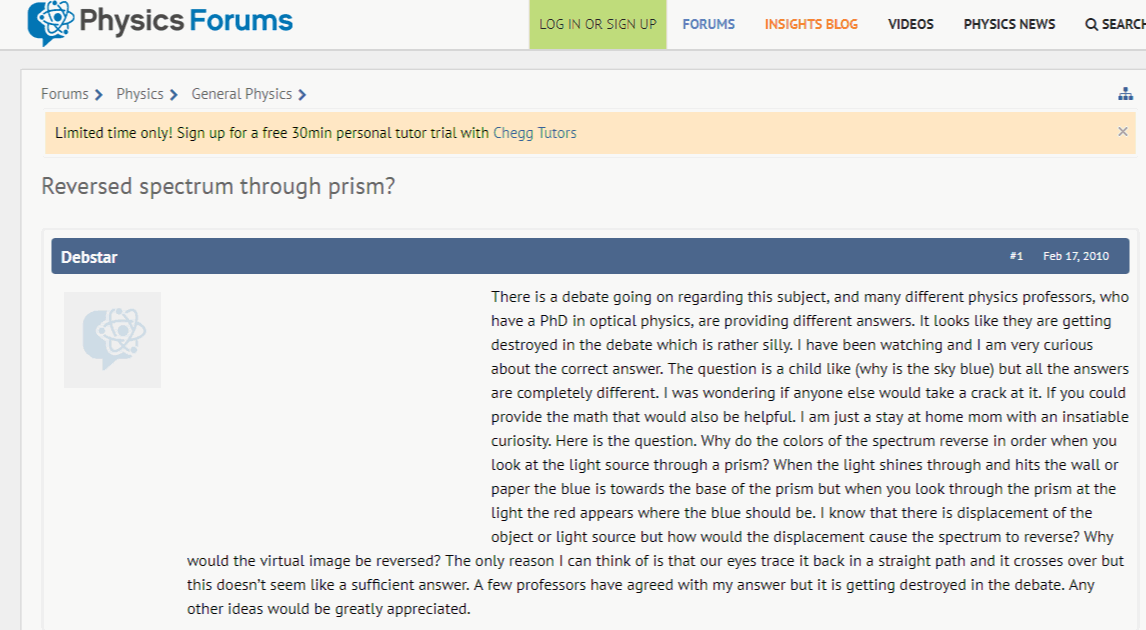On the disarmingly simple and devilishly complicated inverse spectrum of light
It has finally become obvious to me why you do not understand why in a so-called subjective prismatic observation the spectrum appears inversely displayed. It has also become clear very recently in my mind why the conventional physicists have not a clue about the real causes of prismatic experiments, regardless of their so-called subjective or objective nature. Today I'm going to redress that tragic reality and you'll see the truth. Period.
You have had ample opportunity to be aware of how many conventional physicists of the highest pedigree in this world have tried to explain that long known observation that prismatical colours appear to the eye of the observer in inverse order to that cast on a screen. Effectively, VBGYOR instead of ROYGBV, in a direction running from the top towards the bottom of the prism. Today you'll be shown definitive proof that the conventional physicists just plainly cannot do it, regardless of what kind of spin they either have put or will ever put on whatever things they can feel free to choose from.
That's all. Let's go.
A slit is casting a beam of white light onto a converging lens.
The beam is then entering a triangular prism, in which each individual wavelength bends at its own angle. Upon exiting the prism each wavelength bends, again at its own individual angle, a second time around. That results in the observed separation of the spectral colours. The order of the colours in a direction from the apex of the prism to the base is ROYGBV.
That particular order is due to the 'fact' that the speed of R in the prism is slowed down the least, of V the most, and of all the other colours, in between those two in the known order.
That's basically the entire gamut of the conventional view on prismatic phenomena, and--based on known accounts--all mainstream physicists staunchly believe and declare that any other possible prismatic observation can be explained within the boundaries of that context.
Now from all historical accounts that we have gathered since the very times of Sir Isaac Newton to this very other point in time there have been hardly any known challenges or demands calling on the mainstream physicist to please explain why "prismatical colours appear to the eye of the observer in inverse order to that cast on a screen". Personally I'm only aware of two. The first one that I know of was raised by Anthony Lucas in a couple of letters to Newton himself, three and a half centuries back. The second one was raised by a Canadian Engineer called Doug Marsh, only a few years ago. Although I had contacted Mr. Marsh in the past (to which in turn he courteously replied) that remained the entire extent of our communication. (Until five minutes ago, that is, when I sent the man a new email.) You can find his essay here and I suggest you read it.
Since I believe that you have read all the posts of this site you'd be well-aware of my own debates with some of the mainstream physicists out there, but the bare truth is that in all those cases I thought that in the end it was always manifestly obvious where the reality lay. In hindsight that may well have been an error in judgement, on my part.
Overwhelmingly, two conventional replies to my challenges proved to be the most popular, the most used. Here and now I'll deal with them, and with any other if or whenever they might raise their heads in my living future.
Invariably, at some point pretty much everyone with conventional leanings took turns to remind me that things appear inverted on the human retina, and that he--the human--only managed to redress that wrong orientation in his brain via a long evolutionary process. Dr. Dutch did it, and--surprise, surprise--Dr. Selmke did it too. To both of them I replied that one of the first things a common thinker analyses when he encounters the inversely displayed spectrum is exactly that, but that he then dismisses it after thinking about it for no more than a couple of minutes. To that I then added that I will reveal that decisive 2 min line of reasoning if they either asked or dared me. Neither of them did either. So neither did I.
Today however I'll reveal it freely, for you.
If we have only learned to put things right in our brains in the conventional manner then we must have also somehow learned to do it in all possible situations bar one: namely, when we look with the naked eye through a triangular prism at a source of light!!!
So, how long will you need to think about that, before you'll genuinely be able to make a sound sense of it and therefore understand it truly? Time yourself, and remember that I have already given you the answer. Good luck.
That's all about this, let's go to the next one.
The second is the one that was discussed in that Physics Forums thread back in the year of 2010.
Which are factually of this kind of kinds.
Now, to my mind what I had offered was conclusive proof that the conventional view was irrevocably flawed, dead, non-existent, bogus, hot air. But as I said a little earlier above that was until the other day--when I realised that in spite of all my explanations it was rather conspicuous that neither laity nor academia have nowhere near understood what kind of conditions must be met by any would-be explanation. So let me then add to everything that I have said before on this topic the following.
Look carefully at the picture above. Note the Newtonian ROYGBV spectrum that is literally cast onto an intercepting screen after exiting the prism. Think soundly and you should realise that any valid explanation must unquestionably show the same spectrum visibly cast and displayed on some screen of sorts, as well as contain a copy readily observable of the so-called subjective, VBGYOR spectrum within the same experimental setup. This is an absolute and non-negotiable prerequisite for any would-be explanation, and anything less than that should clearly and categorically be deemed unacceptable and therefore rejected out of hand. In view of this condition let me show you then that my particular prismatic setup does meet that requirement, fully. See below.
Not only that, if you look carefully towards the ceiling of the prism you'll readily notice two other inverse spectra, which have been generated by two of the three easily discernable slits.
Here you have a full view of the three inversely displayed spectra. Then below I'll show you in a sequential array of pictures what the observer's eye would see if it is placed not only in the beam of colours that emerge from the prism, but indeed anywhere near and around it as well.
It is time to now present for your scrutiny my own explanation for the observation, even though I have done it before.
The reversed VBGYOR order appears to the naked eye because the picture that it (the eye) gets is basically that of the prism itself and the image of that inversely running spectrum is effectively a travelling companion (or side-effect, if you prefer) embedded with the prism as such.
Let's have a look at a few more pictures now.
Observe and think. Look carefully at the spatial orientation of the objects relative to the orientation of camera's eye, as well as that of the prism itself. Think.
Observe and think. You remember how I explained the apparition of the inverse spectrum. Now look at what the arrow on the left is pointing. Think about that. As I have said, forget about the conventional spill about how diffraction is responsible for such observations. Think. Now put two and two together and you should see.
Take the beam of light marked by the left arrow and put it on the top of the beam (I shouldn't say 'beam', but I can't seem to get anything else at the moment.) that's laying on the floor. It is all visible, from the slit to the refracted beam that is passing on your right. Think.
This is a real picture, not tampered with in any way. It shows an entire process at work: that of refraction. Period.


























































